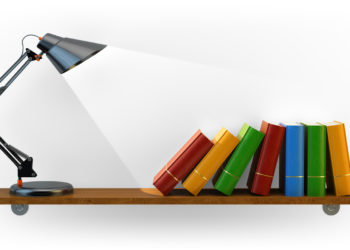In recent weeks, you may have seen mentions of a Washington Post story regarding the number of books Americans read (or did not read) over the course of 2023. The Post based much of its reporting on results from a survey conducted by a senior data journalist over at Yougov.com. As ambitious souls may set personal reading goals to accomplish in the new year (12 books in 2024, 50 books, 75, 100, etc.), the survey results offer an idea of what’s common (while also allowing one to feel secretly superior to a faceless percentage of other Americans). The fourth paragraph of the Washington Post piece noted that “Reading five books put you in the top 33 percent…Those of us who read more than 50 books are the true one-percenters: people who read more books than 99 percent of their fellow Americans.”
Frivolously, I announced on Twitter that I qualified for that top one-percent. I read well over fifty books in 2023 – reading and re-reading fiction and non-fiction across multiple genres, and across a temporal spectrum. Old titles, new titles, nineteenth century three-volume novels, twenty-first century Booker-Prize-winning fiction, some serious scholarly output, even some fairly forgettable “fluff”.
Even so, I was dubious as I went through the Post write-up, and then followed the link to the original post on Yougov.com. The survey asked about the number of books read, the genre, and the format (print v. electronic). The thought that crossed my mind was: at what point do most people deem a book as having been read?
There’s a book on my shelf – The Oxford Reader’s Companion to Anthony Trollope by R.C. Terry (Oxford University Press, 1999). It’s great as a consultative aid when one can’t recall all the names and marital opportunities of the de Courcy daughters or the backstory of Madame Goesler across the multiple volumes of the Palliser series. It’s an attractively illustrated, browsable work of more than 500 entries encompassing Trollope’s output, clocking in at 658 pages. It’s not intended to be read in linear fashion; it’s not a narrative. As I re-read the six Barset novels in 2023, I turned to that book more than once for a quick reminder and other evenings, I passed an hour or so flipping through the pages. Do I count that book as one of the fifty-plus titles read this past year? Or do we just call that a “power browse”?
What are the criteria for being able to state that one has (in fact) read a book, engaged with the text in a meaningful way? The amount of time spent with the book? The degree of attention paid to the content? The reader’s ability to recall and/or summarize the content six months later? Is that a reasonable metric? (Remember Pierre Bayard’s book from 2007, How to Talk About Books You Haven’t Read?) Assessing reader engagement appropriately is a conundrum.
It’s not just whether individuals read; it’s the process used. Some may be aware of the prayer composed by Thomas Cranmer for the Book of Common Prayer in which he encouraged a greater depth of engagement with Scripture, recommending that parishioners “read, mark, learn and inwardly digest”. Those four steps represent a process.
We do know that process may differ according to what’s being read. Consider Samuel Johnson and the Life of Reading (Johns Hopkins Press, 1997) by Robert DeMaria. It is a narrative analysis of Dr. Johnson’s approach to reading as the activity was expanding to a larger population during his lifetime. DeMaria breaks Johnson’s reading activity into four categories – study (or “hard”) reading, perusal, “mere” reading, and “curious” reading. From my scribbled notes (as part of my own process):
- Study (or “Hard) reading was characterized as that done when Johnson knew nothing about a topic. It was the initial foray by a reader into a subject when one’s intent was to acquire new knowledge. Uninterrupted time and devoted attention were necessary.
- Perusal was more succinctly defined as reading when one had a definite outcome in mind; one knew what information was being sought and possessed some sense of where it could be found.
- Mere reading was ephemeral and lower on the scale — the approach used when scanning a printed newspaper for recorded events of the day when retention of might or might not be an important priority.
- Finally, “curious” reading was primarily reserved to reading for entertainment. Despite himself indulging in it, Johnson held this kind of reading in low regard and did not wish to encourage it in others.
We all read a great deal these days — perhaps just not as much serious long-form content as Samuel Johnson would have felt appropriate. But there’s a wrinkle here to be acknowledged.
Robert DiYanni has an interesting perspective in his 2021 book from Princeton University Press. In You Are What You Read: A Practical Guide to Reading Well, he writes: Reading is worthwhile, paradoxically, because it is not absolutely essential for living — it’s not like breathing; it’s not required for getting on in life. Many people succeed without doing much reading…Reading is a luxury more than a necessity, though one, certainly, that enriches our lives. That might seem near heresy but it is a warning against mischaracterizing any group of Americans who don’t choose to read more than a single book in a year. Frederick Douglass managed to develop an entire rhetorical style from a single copy of The Columbian Orator.
An editorial appearing in Library Journal this past December had as its headline, “Re-ignite Reading: Fewer Than Half of American Adults Are Readers“. Hallie Rich, that periodical’s Editor-In-Chief, quoted a statistic from the National Endowment for the Arts. Just under half of Americans (48.5%) reported reading one or more books for pleasure during 2022. That was down from a decade previous when 54.6 percent of the population had reported reading one or more books during the year of 2012. Granted that she appears to be addressing those serving in public libraries rather than academic libraries, the sentence that jumped out at me from Rich’s op-ed was this: LJ readers understand better than most that libraries are lots of things to lots of people, but for many our business is books. To see a sharp decline in reading is both puzzling and disconcerting.
These anxieties are hardly new. During the past 30 years, there have been numerous anxieties expressed by experts over the reading habits of an American population. In the early to mid-nineties, former Secretary of Education William J. Bennett wrote The Book of Virtues – an anthology of “exemplary stories” intended to instill good character or “moral literacy” in children and ease the guilt of working parents (Simon & Schuster, 1993). Alberto Manguel gave us the wonderful A History of Reading in 1996. For the homeschooling parent in 2003, there was a reading list provided by Susan Wise Bauer in The Well-Educated Mind: A Guide to the Classical Education You Never Had.
Alan Jacobs, Distinguished Professor of the Humanities at Baylor University, urged The Pleasures of Reading in an Age of Distraction just one year after Nicholas Carr had alarmed the public about digital rewiring in The Shallows: What the Internet is Doing to Our Brains. In the past decade, we’ve had shorter books with titles like The Lost Art of Reading: Books and Resistance in a Troubled Time by literary critic David Ulin and On Reading Well: Finding the Good Life through Great Books by conservative author and professor Karen Swallow Prior. (Let me say that I’m not the target audience for these titles, but I’m not confident who might be. The books are not emerging from scholarly publishers, although they are largely the product of credentialed experts.)
If there is a common hopeful message across those titles, it is that attentive reading fosters a sense of self and individual philosophy. Allowing time for the slow absorption of long-form content pushes back against mindless societal acceleration. The hope is that the practice counters the effect of Orwell’s “group think”.
So again, where is our gauge for determining whether an adult (not a K-12 student) has actually read a book? What are the real indicators of engagement?
Citations? I mentioned David Ulin’s short book The Lost Art of Reading. The 2009 edition had one subtitle; a subsequent edition in 2018 featured the one mentioned above. Checking Google Scholar I notice that the 2009 edition has gained 15 citations while the 2018 edition shows 9. We know that citation activity in books or of books tends to flow differently across time. We also know that citations can be poorly handled and misreported in any variety of ways.
Writing in the margins? Amazon in 2022 launched their Scribe product, a tablet-like ereader equipped with a stylus pen for writing “sticky notes” on the pages of Kindle editions. It’s a step beyond yellow highlighters but it’s still a step removed from traditional marginalia. It’s not a private thought. Amazon as well as the reader can review their on-the-spot annotations of digital content.
Baylor University’s Alan Jacobs speaks anecdotally of a student in his office who had dog-eared something like 70 pages of a 400 page book assigned for class. He wondered how or whether she’d ever be able to retrieve the passages that puzzled or resonated with her. There are in fact areas where the digital environment may improve efficiency.
Another quote, this time from a special issue of the Sage journal, Digital Pedagogies. Colette Gordon offers an approach towards social annotation in “Reading Literature In/Against the Digital Age: Shallow assumptions, deep problems, and expectant pedagogies”, one that plays into our Age of Distraction. Her approach “emphasizes continuous reading (following the flow of information as it is presented), such reading is necessarily marked, if not marred, by interruption: first as it trains the reader to pause to register narrative possibilities and second as it trains attention of the readings of others…The student still, in a basic sense, reads ‘on the prowl’ (Baron, 2017: 39), although searching for something that cannot be scanned for, but only found in continuous reading.” Educators continue to wrestle with the shifts in reading and the impact on our brains as a result. But (at least in my view) this ought not to be just about ensuring a good reading experience for K-12 students. How are we thinking about the reading habits of working adults? It can’t just be about the number of books read.
Our winter image of an individual under a warm blanket with a great book in hand (usually with a cat or dog curled up at their feet) while snow falls outside is comforting. If one seeks to avoid the Polar Vortex or a January blizzard, there’s much to be said for the isolated reading experience. Left to ourselves, we can find the space and time to absorb meaning. But the less comfortable reality has to do with misplaced priorities. What’s more important – the number of books read by an individual in a specific time frame or the depth of attention paid in absorbing the author’s message or the book’s content?
I don’t object to the use of Re-Ignite Reading as a tagline in a campaign of encouragement nor do I think it’s foolish to see someone embarking on a 75-Book Challenge in 2024. I just think we should abandon the silly news articles that reinforce the idea of quantity over quality. I’d rather see efforts put toward better assessment of adult reader engagement.
Discussion
3 Thoughts on "Reading: It Can’t Be About the Numbers"
Thank you for this interesting column. The sheer amount of information that floods us daily, from so many sources, dilutes our brain’s ability to function. This includes but is not limited to the Internet. Counterintuitively, the popularity of word puzzles is another menace. My own addiction to the New York Times crossword and other daily puzzles is (I hope) preserving my ability to recall factoids — while eating into the time I have to spend each day in deep and “continuous” reading. I hope you are right that quality is more important than quantity when it comes to books.
What a lovely piece. An excellent argument for adopting a “quality” approach to reading.
This article reminds of How to Read a Book by Mortimer J. Adler. I was it back in highschool (I was doing a lot more reading then).


